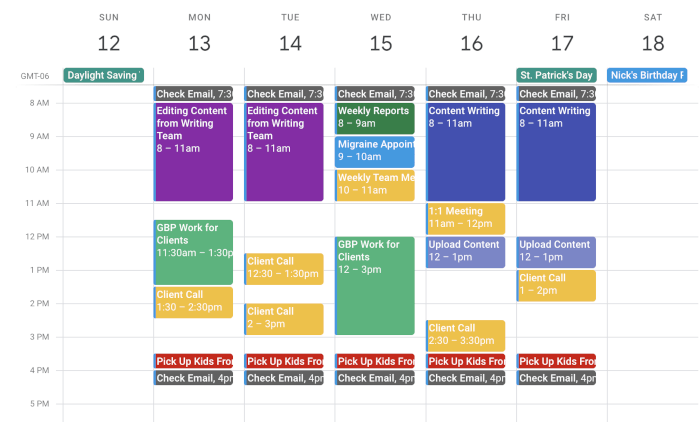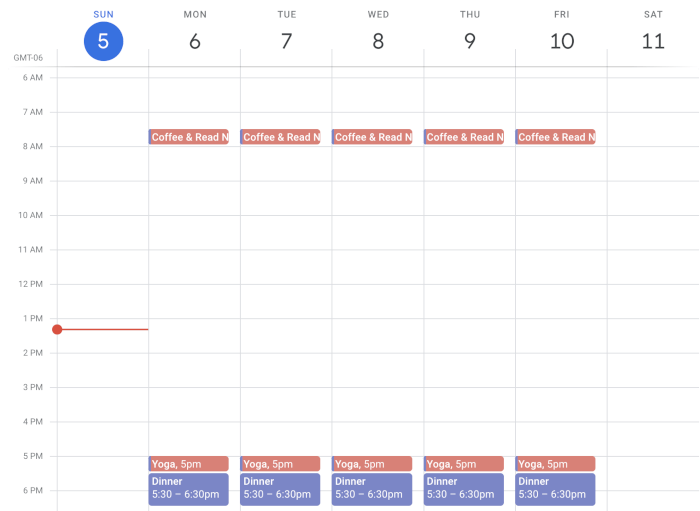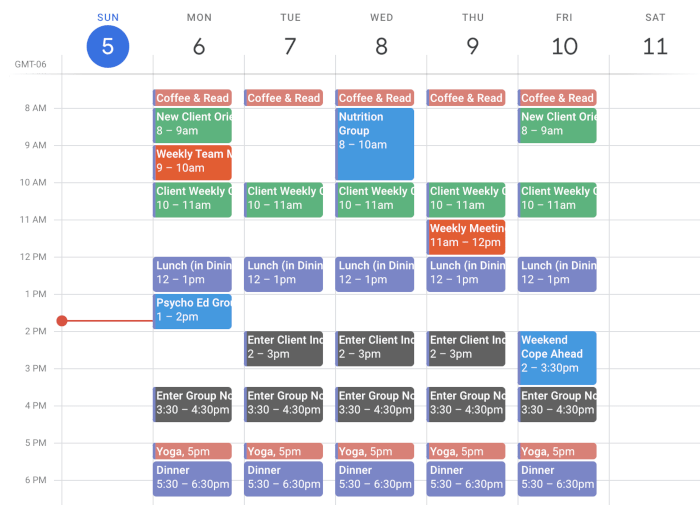
When many people sit down to work or handle household chores, they make a to-do list and try to check each item off one by one. However, many people find they will pick and choose to-do items, avoid others, or become distracted and start doing things that aren’t even on the to-do list.
So, what if instead of sitting down with your to-do list and checking off items one at a time, you sat down and gave each task its own dedicated space on your calendar? Well, if you adopt time blocking, you can!
What Is Time Blocking?
Time blocking is a time management concept in which you divide your entire day into smaller blocks. During these smaller blocks of time, you focus on a single task or a group of similar tasks. Unlike a typical to-do list, time blocking helps you see what tasks you need to work on and gives you dedicated time for each of them.

Typically, people time block out an entire week at once, making it easier for you to wake up each day and tackle items without wasting time deciding what to do first. Then, at the end of each day, you can do a quick review and adjust the rest of the week as needed.
Time blocking can be an excellent strategy for people who feel like they waste time deciding which tasks to focus on or those who often put off specific tasks because they don’t have adequate time to complete them. It’s also a great way to map out your calendar to see when you have free time and when you don’t.
What Time Blocking Looks Like
When you time block, it’s about prioritizing tasks and assigning them space on your calendar for the week. This requires you to know approximately how much time you need to accomplish the task, but beyond that, you are free to schedule things in ways that make sense given any required obligations (meetings, errands, etc.) that are already on your schedule.

The Benefits of Time Blocking
Although it may sound like a lot of work initially, time blocking offers numerous benefits to those who use it. Time blocking makes it easier for most people to focus, meaning they are more productive, detail-oriented, and likely to finish the task. In fact, single-tasking (focusing on one task at a time) can drastically improve your productivity and help avoid distractions.
Other benefits of time blocking include:
- Promotes deep focus
- Raises your awareness regarding how you spend your time
- Eliminates procrastination
- Helps you become more efficient by batching similar tasks
- Shows you exactly how long it takes you to complete specific tasks
- Makes it easier for you to set aside daily time for self-care and mindfulness
How to Get Started With Time Blocking
Now that you understand what time blocking is and its benefits, it’s time to get started. You may feel a bit overwhelmed as you start time blocking for the first time, but following this simple, six-step guide will help.
1. Determine Working Hours, Then Bookend
Before you can even start dedicating blocks of time to tasks, you need to establish what your parameters are. If you are using time blocking for work, then your parameters will more than likely be your work day. So, you’ll sketch out that eight hours (or other amounts of time) for working.
Then, you’ll want to put in what you’ll do immediately before and immediately after your time blocking. For example, the calendar below includes time each morning for coffee and reading the news, while post-work activities include yoga and dinner.

Most people time block for working, but you can do this for home tasks as well. Just remember to always have a consistent routine on either end your time blocking because it will help you focus your mind at the beginning of the day and unplug at the end.
2. Generate Your To-Do List
Once you’ve outlined the hours you have to work with, it’s time to make your to-do list. This list should include recurring tasks you do daily or weekly for work, but can also include one-off tasks or seasonal tasks that only last for a certain number of weeks. You can reference your company’s task management app or simply jot down everything on a paper list.
It’s okay if you miss something initially or an emergency task comes up mid-week. Just try to cover as much as you can during your initial plans, and then handle what comes up with buffers you’ll build into the calendar. Also, make sure you star any time-specific tasks, like meetings, appointments, or real-time training.
3. Estimate Time Needed for Tasks
Once you have a list of recurring and one-off tasks, you can look at each task and estimate how much time it will take based on your background knowledge and information provided by others. Next to each task, write down how much time you anticipate needing to complete it (i.e., two hours or 30 minutes).
4. Block Out Tasks
Now that you know how long each task will take, it’s time to start blocking everything out. To start, list out anything that is time sensitive (ex. a meeting with your boss that happens at 11:00am every Thursday). Then, find the most logical place for all of the other tasks based on how much time they will take and how high of a priority they are.

5. Insert Time for Reactive Items
When you block out time, make sure you don’t try to stuff everything in with no buffers. This will only make it more difficult to maintain your time-blocking plan throughout the course of the week if emergencies crop up. In the example calendar above, you can see gaps in each day where reactive tasks like email, phone calls, and last-minute meetings could be scheduled as needed.
6. Set Aside Time to Reflect and Adjust
Time blocking is never something you just “set and forget” because our schedules are constantly changing. However, you can prepare a general template, then set aside time daily and weekly to reflect on what’s working and what’s not. Then, you can adjust as needed for changes in your schedule or lessons you learn along the way.
Frequently Asked Questions
Is time blocking the same as time boxing?
Although time blocking and time boxing sound like similar things, they are slightly different. With time blocking, you determine the amount of time each task will take and set aside time for it. With time boxing, you impose limits regarding how long you’re allowed to spend on tasks. Instead of mapping out your day, time boxing places constraints on certain tasks that you may otherwise spend too much time on.
Are there apps that can help me with time blocking?
Yes, there are many apps available to help with time blocking. Lots of people simply use Google Calendar to block out their time, but other options include Sunsama, HourStack, Clockwise, and Planyway.
Image credit: Pexels











